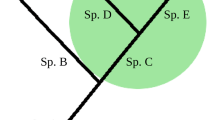Abstract
Hyperthermophiles, growing optimally at 80°C and above had been discovered in 1981. They represent the upper temperature border of life and are found within high temperature environments. In their basically anaerobic surroundings, they gain energy mainly by inorganic redox reactions. Within the phylogenetic tree, hyperthermophiles occupy all the short deep branches closest to the root. The earliest archaeal phylogenetic lineage is represented by the extremely tiny members of the novel kingdom of Nanoarchaeota.










Similar content being viewed by others
References
Ashkin A, Dziedzic JM (1987) Optical trapping and manipulation of viruses and bacteria. Science 235:1517–1520
Blöchl E, Rachel R, Burggraf S, Hafenbradl D, Jannasch HW, Stetter KO (1997) Pyrolobus fumarii, gen. and sp. nov., represents a novel group of archaea, extending the upper temperature limit for life to 113°C. Extremophiles 1:14–21
Brock TD (1978) Thermophilic microorganisms and life at high temperatures. Springer, Berlin Heidelberg New York
Brock TD, Brock KM, Belly RT, Weiss RL (1972) Sulfolobus: a new genus of sulphur oxidizing bacteria living at low pH and high temperature. Arch Microbiol 84:54–68
Castenholz RW (1979) Evolution and ecology of thermophilic microorganisms. In: Shilo M (eds) Strategies of microbial life in extreme environments. Verlag Chemie, Weinheim pp 373–392
Huber R, Wilharm T, Huber D, Trincone A, Burggraf S, König H, Rachel R, Rockinger I, Fricke H, Stetter KO (1992) Aquifex pyrophilus gen. nov. sp. nov., represents a novel group of marine hyperthermophilic hydrogen-oxidizing bacteria. Syst Appl Microbiol 15:340–351
Huber R, Burggraf S, Mayer T, Barns SM, Rossnagel P, Stetter KO (1995) Isolation of a hyperthermophilic archaeum predicted by in situ RNA analysis. Nature 376:57–58
Huber R, Eder W, Heldwein S, Wanner G, Huber H, Rachel R, Stetter KO (1998) Thermocrinis ruber gen. nov., sp. nov., a pink-filament-forming hyperthermophilic bacterium isolated from Yellowstone National Park application. Environ Microbiol 64:3576–3583
Huber H, Hohn MJ, Rachel R, Fuchs T, Wimmer VC, Stetter KO (2002) A new phylum of Archaea represented by a nanosized hyperthermophilic symbiont. Nature 417:63–67
Stetter KO (1982) Ultrathin mycelia-forming organisms from submarine volcanic areas having an optimum growth temperature of 105°C. Nature 300:258–260
Stetter KO (1992) Life at the upper temperature border. In: Tran Thanh Van J, Tran Thanh Van K, Mounolou JC, Schneider J, McKay C (eds) Frontiers of life. Editions Frontieres, Gif-sur-Yvette pp 195–219
Stetter KO (2005) Volcanoes, hydrothermal venting, and the origin of life. In: Marti J, Ernst GGJ (eds) Volcanoes and the environment. Cambridge University Press, Cambridge pp 175–206
Stetter KO, Thomm M, Winter J, Wildgruber G, Huber H, Zillig W, Janecovic D, König H, Palm P, Wunderl S (1981) Methanothermus fervidus, sp. nov., a novel extremely thermophilic methanogen isolated from an Icelandic hot spring. Zbl. Bakt Hyg I Abt Orig C2:166–178
Stetter KO, Huber R, Blöchl E, Kurr M, Eden RD, Fielder M, Cash H, Vance I (1993) Hyperthermophilic archaea are thriving in deep North Sea and Alaskan oil reservoirs. Nature 365:743–745
Waters E, Hohn MJ, Ahel I, Graham DE, Adams MD, Barnstead M, Beeson KY, Bibbs L, Bolanos R, Keller M, Kretz K, Lin X, Mathur E, Ni J, Podar M, Richardson T, Sutton GG, Simon M, Söll D, Stetter KO, Short JM, Noordewier M (2003) The genome of Nanoarchaeum equitans: Insights into early archaeal evolution and derived parasitism. Proc Natl Acad Sci USA 100:12984–12988
Woese CR, Fox GE (1977) Phylogenetic structure of the prokaryotic domain: the primary kingdoms. Proc Natl Acad Sci USA 74:5088–5090
Zillig W, Stetter KO, Janekovic D (1979) DNA-dependent RNA polymerase from the archaebacterium Sulfolobus acidocaldarius. Eur J Biochem 96:597–604
Zillig W, Stetter KO, Schäfer W, Janekovic D, Wunderl S, Holz I, Palm P (1981) Thermoproteales: a novel type of extremely thermoacidophilic anaerobic archaebacteria isolated from Icelandic solfataras. Zbl Bakt Hyg I Abt Orig C2:205–227
Author information
Authors and Affiliations
Corresponding author
Additional information
Communicated by K. Horikoshi
Rights and permissions
About this article
Cite this article
Stetter, K.O. History of discovery of the first hyperthermophiles. Extremophiles 10, 357–362 (2006). https://doi.org/10.1007/s00792-006-0012-7
Received:
Accepted:
Published:
Issue Date:
DOI: https://doi.org/10.1007/s00792-006-0012-7




